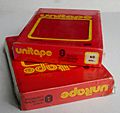8 track tape facts for kids
The 8-track was a way to listen to music, like CDs or streaming today. It first came out in the 1960s. People mostly used 8-tracks to play music in their cars.
Unlike modern cassettes, 8-tracks used a tape that was a continuous loop. This meant you didn't need to flip the tape over to keep listening. Each tape had four sections of music, called "programs." Each program had two tracks for stereo sound. When one track finished, a small piece of metal on the tape told the player to switch to the next track. 8-tracks became very popular in the early 1970s. People used them both at home and in their cars.
The Rise and Fall of 8-Tracks
In the 1970s, cassette tapes got much better. They started to sound clearer than 8-tracks. By the late 1970s, cassettes were more popular.
By 1980, companies almost stopped making 8-tracks. You could still buy them through mail order record clubs until 1987. Today, only a few people still collect and listen to 8-tracks.
Common Problems with 8-Tracks
The 8-track system had some issues. The rubber roller, which helped the tape move, was inside the cartridge. This roller often wore out. When it did, it could make the tape gooey and cause it to break easily.
Also, the music tracks on the tape were very close together. Sometimes, you could hear music from the next track while listening to another. The small metal foil that told the player to switch tracks could also break off. If this happened, the tape would not change tracks correctly.
Images for kids
-
Factory optional 8-track stereo player in a 1967 American Motors Marlin mounted between the center console and dash
See also
 In Spanish: Cartucho de 8 pistas para niños
In Spanish: Cartucho de 8 pistas para niños







